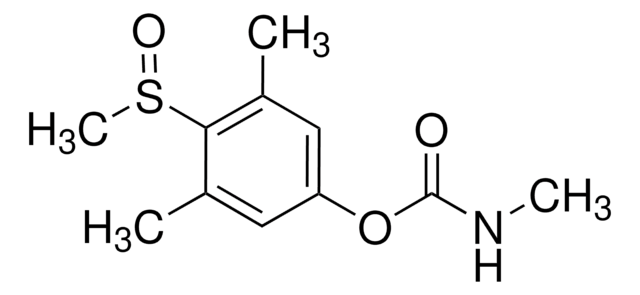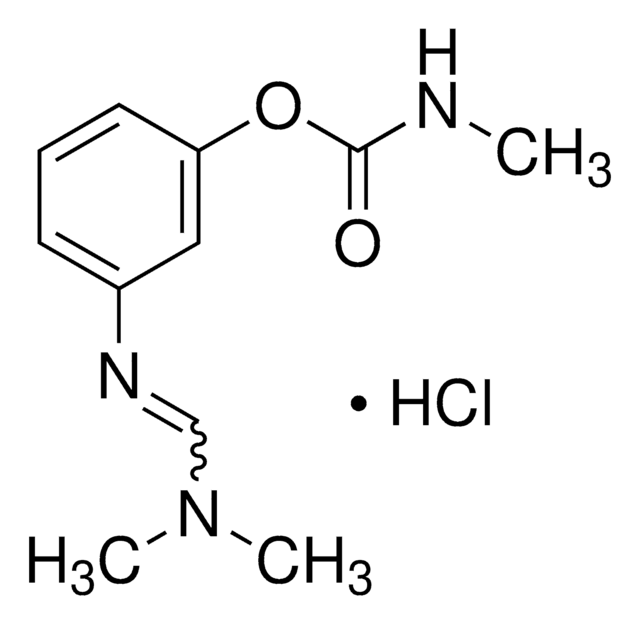CRM67124
Methiocarb sulfone
certified reference material, TraceCERT®, Manufactured by: Sigma-Aldrich Production GmbH, Switzerland
Synonym(s):
Mercaptodimethursulfon, Methiocarb sulfone
About This Item
Recommended Products
grade
certified reference material
TraceCERT®
Quality Level
product line
TraceCERT®
shelf life
limited shelf life, expiry date on the label
manufacturer/tradename
Manufactured by: Sigma-Aldrich Production GmbH, Switzerland
storage temp.
2-8°C
SMILES string
CNC(=O)Oc1cc(C)c(c(C)c1)S(C)(=O)=O
InChI
1S/C11H15NO4S/c1-7-5-9(16-11(13)12-3)6-8(2)10(7)17(4,14)15/h5-6H,1-4H3,(H,12,13)
InChI key
RJBJMKAMQIOAML-UHFFFAOYSA-N
Looking for similar products? Visit Product Comparison Guide
Related Categories
General description
Certified content by quantitative NMR incl. uncertainty and expiry date are given on the certificate.
Download your certificate at: http://www.sigma-aldrich.com
Methiocarb sulfone is a carbamate pesticide and one of the four metabolites of insecticide, molluscicide, and bird-repellent methiocarb.
As per the commission implementing regulation (EU) 2019/1606 of 27th September 2019, methiocarb (expressed as the sum of methiocarb, methiocarb sulfone, and methiocarb sulfoxide) is not approved for use in the European Union. Maximum residue levels (MRLs) have been set according to Reg (EC) No 149/2008 for methiocarb (expressed as the sum of methiocarb, methiocarb sulfone, and methiocarb sulfoxide) for various products of plant and animal origin from 0.01 to 0.1 mg/kg. Methiocarb has to be monitored in the Multiannual Control Program for Pesticides Residues (MACP), run within the EU and EFTA in/on products of plant origin.
Application
The methiocarb sulfone CRM may also find following uses:
- Method development for simultaneous determination of methiocarb, methiocarb sulfoxide, and methiocarb sulfone in five food products of animal origin (milk, chicken, pork, beef, and eggs) by liquid chromatography-tandem mass spectrometry (LC-MS/MS)
- Determination of 304 pesticide residues in citrus fruit (grapefruit, lemon, orange and mandarin) and vegetable (cucumber, eggplant, tomato and zucchini) samples by liquid chromatography-tandem mass spectroscopy (LC-MS/MS)
- Analysis of environmental water samples for the presence of 23 carbamate pesticide residues by solid-phase extraction (SPE) combined with ultra-high-performance liquid chromatography-tandem mass spectrometry (UHPLC-MS/MS)
- Develop a UHPLC-MS/MS method to determine 28 carbamate pesticide residues in fresh herb samples of basil, spearmint, wild mint, parsley, Chinese parsley, thyme, chives, and salvia after their QuEChERS-based extraction
- Validation of a method based on QuEChERS extraction and LC-MS/MS and GC-MS/MS quantification of 218 pesticide residues in clay loam soil
- Multi-residue analysis of pesticides and mycotoxins in red wine using direct injection for sample preparation and UPLC-MS/MS for analysis
- Method development for detection and quantification of 260 pesticides and mycotoxins in green tea and royal jelly nutraceutical products by “dilute and shoot” extraction procedure and quantification by LC-Orbitrap-MS
Recommended products
Legal Information
Signal Word
Warning
Hazard Statements
Precautionary Statements
Hazard Classifications
Acute Tox. 4 Oral
Storage Class Code
11 - Combustible Solids
WGK
WGK 3
Flash Point(F)
Not applicable
Flash Point(C)
Not applicable
Choose from one of the most recent versions:
Certificates of Analysis (COA)
Don't see the Right Version?
If you require a particular version, you can look up a specific certificate by the Lot or Batch number.
Already Own This Product?
Find documentation for the products that you have recently purchased in the Document Library.
Our team of scientists has experience in all areas of research including Life Science, Material Science, Chemical Synthesis, Chromatography, Analytical and many others.
Contact Technical Service








